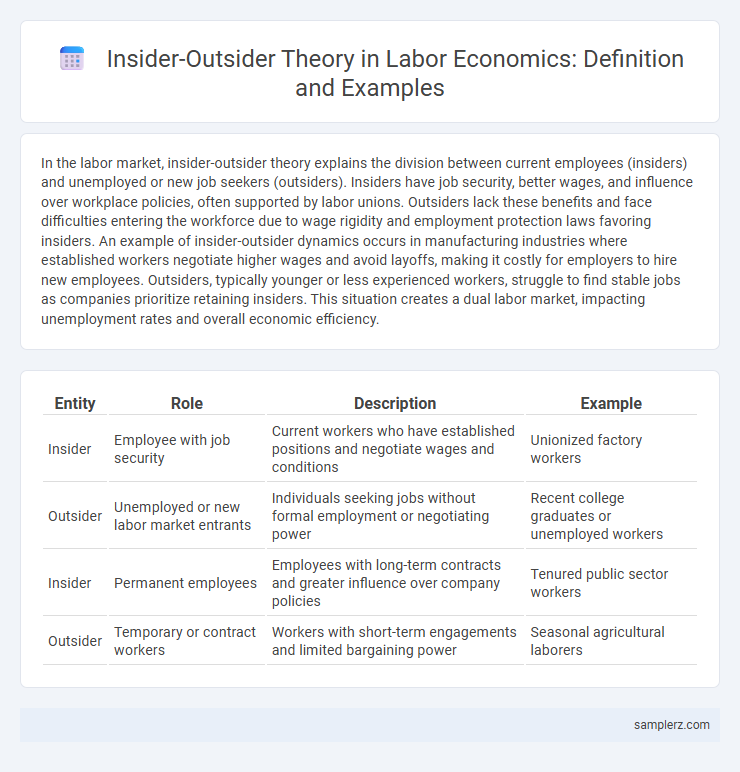In the labor market, insider-outsider theory explains the division between current employees (insiders) and unemployed or new job seekers (outsiders). Insiders have job security, better wages, and influence over workplace policies, often supported by labor unions. Outsiders lack these benefits and face difficulties entering the workforce due to wage rigidity and employment protection laws favoring insiders. An example of insider-outsider dynamics occurs in manufacturing industries where established workers negotiate higher wages and avoid layoffs, making it costly for employers to hire new employees. Outsiders, typically younger or less experienced workers, struggle to find stable jobs as companies prioritize retaining insiders. This situation creates a dual labor market, impacting unemployment rates and overall economic efficiency.
Table of Comparison
| Entity | Role | Description | Example |
|---|---|---|---|
| Insider | Employee with job security | Current workers who have established positions and negotiate wages and conditions | Unionized factory workers |
| Outsider | Unemployed or new labor market entrants | Individuals seeking jobs without formal employment or negotiating power | Recent college graduates or unemployed workers |
| Insider | Permanent employees | Employees with long-term contracts and greater influence over company policies | Tenured public sector workers |
| Outsider | Temporary or contract workers | Workers with short-term engagements and limited bargaining power | Seasonal agricultural laborers |
Defining the Insider-Outsider Theory in Labor Markets
The Insider-Outsider Theory in labor markets distinguishes between insiders, who are current employees with job security and bargaining power, and outsiders, unemployed or new workers facing barriers to entry and less influence over wages. Insiders leverage their established positions to negotiate higher wages and better conditions, often resulting in labor market rigidities and inequality. This dynamic creates challenges for unemployed outsiders attempting to access stable employment and contributes to persistent unemployment rates.
Classic Examples of Insider-Outsider Dynamics in Employment
Classic examples of insider-outsider dynamics in employment include unionized labor markets where existing employees (insiders) benefit from wage policies and job security, while unemployed or new workers (outsiders) face barriers to entry. Restrictions such as high minimum wages and strict hiring regulations protect insiders but limit outsiders' opportunities for employment. This divide reinforces labor market segmentation, contributing to persistent unemployment and wage disparities.
Insider Advantages: Job Security and Wage Negotiations
Insiders in the labor market benefit from significant job security due to established contracts and seniority protections, which often shield them from layoffs during economic downturns. They leverage their position to negotiate higher wages and better benefits, creating a wage premium over outsiders who face unstable employment and limited bargaining power. This insider advantage contributes to labor market segmentation, where outsiders experience persistent unemployment or underemployment despite economic growth.
Outsider Challenges: Barriers to Labor Market Entry
Outsiders in the labor market face significant challenges including limited access to stable employment due to high entry barriers like stringent qualification requirements and employer preference for experienced candidates. These barriers often result in prolonged unemployment or underemployment for outsiders, exacerbating income inequality and social exclusion. Labor market rigidities and lack of adequate training programs further hinder the ability of outsiders to compete effectively against established insiders.
Youth Unemployment as an Outsider Phenomenon
Youth unemployment exemplifies the insider-outsider labor market model, where established workers (insiders) secure job stability and protect wages, while young job seekers (outsiders) face barriers to entry and prolonged joblessness. This dynamic creates segmented labor markets with restricted mobility for youth, exacerbating structural unemployment and underemployment among young populations. Policymakers target active labor market programs and apprenticeship schemes to integrate youth outsiders into the workforce and reduce unemployment rates.
Temporary vs. Permanent Contracts: Insider-Outsider Divide
The insider-outsider labor market divide is evident in the contrast between employees with permanent contracts and those on temporary contracts. Permanent workers, considered insiders, enjoy greater job security, access to benefits, and stronger bargaining power, while temporary workers face job instability and limited rights. This divide exacerbates wage disparities and impacts overall labor market flexibility and productivity.
Unionization and the Protection of Insiders
Unionization often strengthens the position of labor insiders by securing higher wages and job stability through collective bargaining agreements, which inadvertently marginalizes outsiders such as unemployed or non-unionized workers. The protection of insiders creates barriers to entry in the labor market, limiting employment opportunities for outsiders and contributing to labor market segmentation. Empirical studies show that union-protected insiders enjoy wage premiums and job security at the expense of reduced mobility and access for outsiders.
Technological Change and the Shifting Insider-Outsider Gap
Technological change significantly alters the insider-outsider gap in labor markets by favoring insiders who adapt to new tools and processes, while outsiders struggle to acquire relevant skills. Automation and digitalization increase demand for high-skilled workers, intensifying wage disparities and employment opportunities between established employees and marginalized job seekers. Policymakers must address this gap through targeted training programs to ensure inclusive labor market transitions amidst rapid technological advancements.
Policy Responses to Insider-Outsider Labor Market Issues
Policy responses to insider-outsider labor market issues often involve targeted wage subsidies aimed at reducing unemployment among outsiders without distorting wages for insiders. Active labor market programs, such as retraining and job placement services, enhance outsiders' employability while preserving insiders' job security. Labor market reforms that increase flexibility in hiring and firing have been implemented in countries like Germany and Sweden to balance protection for insiders with opportunities for outsiders.
Economic Consequences of Insider-Outsider Segmentation
Insider-outsider segmentation in the labor market creates distinct economic consequences, such as wage rigidity, unemployment disparities, and reduced labor mobility. Insiders--typically permanent employees--benefit from higher wages and job security, while outsiders face precarious employment and limited access to benefits, leading to structural unemployment. This segmentation hampers overall economic growth by reducing labor market flexibility and increasing inequality.

example of insider-outsider in labor Infographic
 samplerz.com
samplerz.com